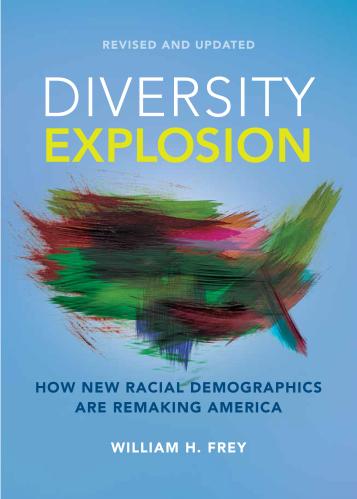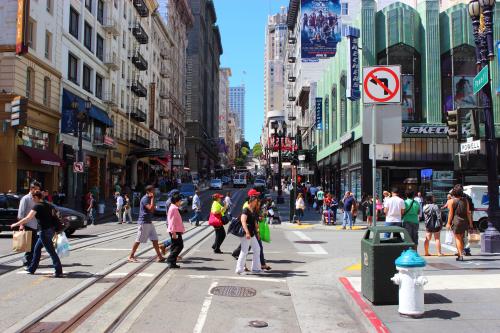Millennials are now the largest adult generation in the U.S., and due to their valuable attributes—their education, diversity, unbounded optimism, and energy—they are highly sought after by communities all over the country. Yet metropolitan areas differ widely in both the growth of this highly prized generation and also in their demographic “footprint,” measured as their share of the total population.
Drawing from my report, “The millennial generation: A demographic bridge to America’s diverse future,” the maps below depict the range of millennial growth and presence across the nation’s 100 largest metropolitan areas over the first half of this decade.
Metropolitan area millennial growth
The young adult population ages 18-34 grew nationally by 4.7 percent during the decade’s first half.[i] The map below displays metropolitan areas, among the nation’s 100 largest, that registered the highest and lowest millennial growth over this period. Each of the 10 fastest-growing areas, with millennial growth rates exceeding 10 percent, are located in the South or West. Two (Colorado Springs and Denver) are located in Colorado, three (San Antonio, Austin, and Houston) are in Texas, and another three (Orlando, Cape Coral, and North Port-Sarasota) are in Florida. Rounding out the list are Honolulu and Seattle (download Table 1).

Only one metropolitan area—Birmingham, Ala.—exhibited a decline in young adults. Most of the other areas with the lowest millennial growth are located in the industrial North and Midwest, including Chicago, St. Louis, Milwaukee, and Syracuse along with the Ohio areas of Toledo, Youngstown, and Dayton. Also on this list are Salt Lake City and Jackson, Miss.
Metropolitan area millennial footprints
The millennial footprint—the generation’s share of the total population—provides a measure of how much demographic clout the millennial population can exert. At mid-decade, millennials comprised nearly a quarter (23.4 percent) of the national population, but this share varies widely across metropolitan areas. The map below displays metropolitan areas with the highest and lowest shares of millennials.
Map 2: Millennial share of population
Millennial footprints range from 30.4 percent in Provo, Utah, down to just 15.9 percent in North Port-Sarasota, Fla. The 15 metropolitan areas with the highest shares of millennials are all in the fast-growing South and West, with the exception of Madison, Wis., a university town and state capital—an attribute it has in common with Austin, which has the second-highest millennial share, and other areas with above average millennial growth (Baton Rouge and Columbus, Ohio).
Four of the areas with the highest shares are in California: San Diego, Bakersfield, Fresno, and Los Angeles (download Table 2).
Some areas with the lowest millennial shares are in Florida, where they are sometimes crowded out by older generations, but other areas with low millennial shares are located in the Northeast and Midwest. Included among the Florida group are Cape Coral, Palm Bay, Deltona-Daytona Beach, Tampa, Lakeland, and Miami. Among those in the Northeast and Midwest are Youngstown, Bridgeport, Cleveland, Detroit, and the Pennsylvania areas of Allentown, Scranton, and Pittsburgh.
Overall, with a few exceptions like Florida, the South and West “Sun Belt” areas tend to show the highest growth and biggest millennial footprints, while those in the North and West “Snow Belt” areas are more likely to register low growth and smaller millennial shares. This bodes well for millennials’ impact in the more rapidly growing regions of the country.
[i] This represents gains from immigration and the aging of younger millennials into the 18-34 age bracket during that time. However, this pattern of young adult growth differs across metropolitan areas according to the extent to which: (1) they attract immigrants; (2) young millennials age into the 18-34 age bracket; and (3) these areas gain or lose domestic migrants with other parts of the U.S. The combination of these components yields the overall young adult growth rate for a given metropolitan area.








Commentary
Millennial growth and “footprints” are greatest in the South and West
March 6, 2018